
The Marshall Islands, officially the Republic of the Marshall Islands, is an island country west of the International Date Line and north of the equator in the Micronesia region in the Northwestern Pacific Ocean. The territory consists of 29 coral atolls and five islands, divided across two island chains: Ratak in the east and Ralik in the west. 97.87% of its territory is water, the largest proportion of water to land of any sovereign state. The country shares maritime boundaries with Wake Island to the north, Kiribati to the southeast, Nauru to the south, and the Federated States of Micronesia to the west. The capital and largest city is Majuro, home to approximately half of the country's population.

Micronesia is a subregion of Oceania, consisting of about 2,000 small islands in the Northwestern Pacific Ocean. It has a close shared cultural history with three other island regions: Maritime Southeast Asia to the west, Polynesia to the east, and Melanesia to the south—as well as with the wider community of Austronesian peoples.

The Marshall Plan was an American initiative enacted in 1948 to provide foreign aid to Western Europe. The United States transferred $13.3 billion in economic recovery programs to Western European economies after the end of World War II. Replacing an earlier proposal for a Morgenthau Plan, it operated for four years beginning on April 3, 1948, though in 1951, the Marshall Plan was largely replaced by the Mutual Security Act. The goals of the United States were to rebuild war-torn regions, remove trade barriers, modernize industry, improve European prosperity and prevent the spread of communism. The Marshall Plan proposed the reduction of interstate barriers and the economic integration of the European Continent while also encouraging an increase in productivity as well as the adoption of modern business procedures.

George Catlett Marshall Jr. was an American army officer and statesman. He rose through the United States Army to become Chief of Staff of the U.S. Army under Presidents Franklin D. Roosevelt and Harry S. Truman, then served as Secretary of State and Secretary of Defense under Truman. Winston Churchill lauded Marshall as the "organizer of victory" for his leadership of the Allied victory in World War II. During the subsequent year, he attempted to but failed to avoid the impending Chinese Civil War. As Secretary of State, Marshall advocated for a U.S. economic and political commitment to post-war European recovery, including the Marshall Plan that bore his name. In recognition of this work, he was awarded the Nobel Peace Prize in 1953, the only Army general ever to receive the honor.
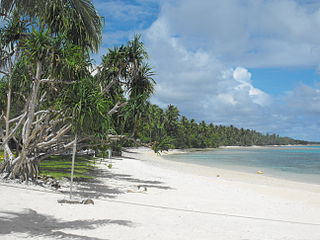
Majuro is the capital and largest city of the Marshall Islands. It is also a large coral atoll of 64 islands in the Pacific Ocean. It forms a legislative district of the Ratak (Sunrise) Chain of the Marshall Islands. The atoll has a land area of 9.7 square kilometers (3.7 sq mi) and encloses a lagoon of 295 square kilometers (114 sq mi). As with other atolls in the Marshall Islands, Majuro consists of narrow land masses. It has a tropical trade wind climate, with an average temperature of 27 °C (81 °F).

Thoroughgood "Thurgood" Marshall was an American civil rights lawyer and jurist who served as an associate justice of the Supreme Court of the United States from 1967 until 1991. He was the Supreme Court's first African-American justice. Prior to his judicial service, he was an attorney who fought for civil rights, leading the NAACP Legal Defense and Educational Fund. Marshall was a prominent figure in the movement to end racial segregation in American public schools. He won 29 of the 32 civil rights cases he argued before the Supreme Court, culminating in the Court's landmark 1954 decision in Brown v. Board of Education, which rejected the separate but equal doctrine and held segregation in public education to be unconstitutional. President Lyndon B. Johnson appointed Marshall to the Supreme Court in 1967. A staunch liberal, he frequently dissented as the Court became increasingly conservative.
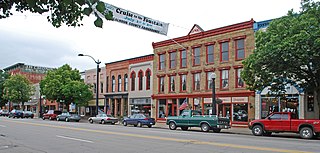
Marshall is a city and the county seat of Calhoun County, Michigan. The population was 6,822 at the 2020 census.
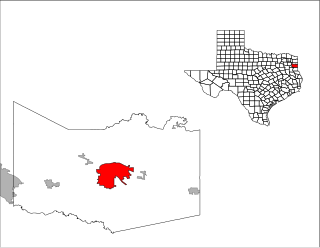
Marshall is a city in the U.S. state of Texas. It is the county seat of Harrison County and a cultural and educational center of the Ark-La-Tex region. At the 2020 U.S. census, the population of Marshall was 23,392; The population of the Greater Marshall area, comprising all of Harrison County, was 65,631 in 2010, and 66,726 in 2018.

Marshalls is an American chain of off-price department stores owned by TJX Companies. Marshalls has over 1,000 American stores, including larger stores named Marshalls Mega Store, covering 49 states and Puerto Rico, and 61 stores in Canada. Marshalls first expanded into Canada in March 2011.

The Pacific Proving Grounds was the name given by the United States government to a number of sites in the Marshall Islands and a few other sites in the Pacific Ocean at which it conducted nuclear testing between 1946 and 1962. The U.S. tested a nuclear weapon on Bikini Atoll on June 30, 1946. This was followed by Baker on July 24, 1946.
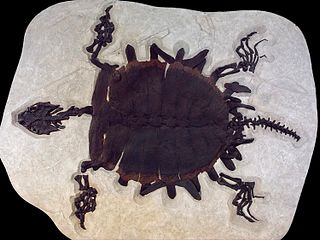
Axestemys is an extinct genus of softshell turtle that lived from the Late Cretaceous to the Eocene in western North America and Europe.

Galechirus is an extinct genus of anomodont therapsids. It was about 30 cm (1 ft) long.

Michael Gregg Marshall is an American college basketball coach whose most recent position was head coach at Wichita State University. Marshall has coached his teams to appearances in the NCAA Division I men's basketball tournament in 14 of 22 years as a head coach. He is the winningest head coach in Wichita State and Winthrop history with 331 and 194 wins, respectively. He resigned on November 17, 2020, after an internal investigation following allegations by multiple former players detailing physical and verbal abuse at the hands of Marshall. Marshall was paid a settlement of $7,750,000 by Wichita State for his resignation.
Syringogaster is a genus of small ant-mimicking flies with a petiolate abdomen, a long prothorax, a swollen and spiny hind femur, and reduced head size and large eyes. There are 20 described extant species and two species known from Miocene amber from the Dominican Republic. It is the only genus in the family Syringogastridae.
Mount Marshall is a mountain located in the town of Newcomb in Essex County, New York. Originally named for Governor DeWitt Clinton, and then for mountain guide Herbert Clark, it was renamed for wilderness activist Bob Marshall after his death. Mount Marshall is part of the MacIntyre Range, and is flanked to the northeast by Cold Brook Pass and Iroquois Peak. The summit can be accessed by hikers on an unmarked trail.

Marshall Bus was an English builder of bus and coach bodies based in Cambridge. It was owned by the Marshall Group until sold in a management buyout in 2001.

The Walter and Mary Ellen Rudin House is a Frank Lloyd Wright-designed Marshall Erdman prefab building located at 110 Marinette Trail, Madison, Wisconsin. Designed in 1957, it is the first of the only two examples of the second type of the Marshall Erdman Prefab Houses. This house and the James McBean Residence have the same floor plan and vary only in minor details such as paint color and siting. Construction was completed in June, 1959 and the house was sold to UW-Madison mathematicians Walter and Mary Ellen Rudin.

John Marshall was an American statesman, lawyer, and Founding Father who served as the fourth chief justice of the United States from 1801 until his death in 1835. He remains the longest-serving chief justice and fourth-longest serving justice in the history of the U.S. Supreme Court, and is widely regarded as one of the most influential justices ever to serve. Prior to joining the court, Marshall briefly served as both the U.S. secretary of state under President John Adams, and a representative, in the U.S. House of Representatives from Virginia, thereby making him one of the few Americans to serve on all three branches of the United States federal government.
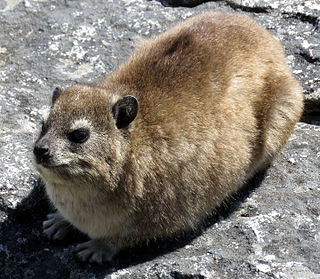
Hyraxes, also called dassies, are small, thickset, herbivorous mammals in the order Hyracoidea. Hyraxes are well-furred, rotund animals with short tails. Typically, they measure between 30 and 70 cm long and weigh between 2 and 5 kg. They are superficially similar to pikas and marmots, but are more closely related to elephants and sea cows.
The Joe Bell site (9MG28) is an archaeological site located in Morgan County, Georgia underneath Lake Oconee, but prior to the 1970s, it was located south of the mouth of the Apalachee River on the western bank of the Oconee River. The junction of these two rivers could be seen from the site. This site was first visited by Marshall Williams in 1968 at the suggestion of the site’s landowner, Joe Bell, who had discovered various artifacts while the site was being regularly plowed. Because of Interstate construction, Marshall Williams and Mark Williams discovered this site during surface surveys and excavations of the plowed areas. The site was excavated and analyzed by Mark Williams as part of his PhD dissertation. During the 1969 excavations, four areas within the site were designated for excavation. In Areas 1-3 various five foot square units were excavated. No excavations were done in Area 4 in 1969. Large quantities of small potsherds were discovered during these excavations, and they ranged from the Duvall Phase in Area 1 to Bell Phase in Areas 2-4. As part of the 1969 excavations, a road grading machine took off the topsoil of twelve strips on the site. This uncovered Features 1 and 2, and they were completely excavated. In 1977, the site was revisited by Marshall Williams and Mark Williams. Since various plans threatened this site, major excavations took place from June 15, 1977 until September 16, 1977 by Mark Williams. Most of the work centered on Area 2 or the Bell Phase portion of the site. The Bell Phase portion of this site was probably no more the 1.5 acres (1 ha). Because of time constraints, only 17 of 55 features were excavated, and no more than a handful of the 1100 posts were excavated. A few trips were made back to the site the following year with the help of volunteers, and approximately 80% of the area stripped by heavy machinery was mapped. Some of the features were trash features that consisted of a circular pit filled with food residues and pottery sherds. Evidence of a large circular structure or rotunda was found at the site. It was the social, political, and religious center for the inhabitants. A large quantity of the features was small, circular, semi-subterranean structures that were probably used as sleeping quarters on cold nights. Another structure found was warm weather structures. One major trash feature was found that had been deposited in a single episode and was burned during or after deposition. Numerous sherds were found in this pit, and many reconstructable vessels were present. Ethnohistoric literature of the Southeast suggests that this feature was formed during a Busk or Green Corn ceremony. The ceremony has been described as the physical cleansing of the town.



















